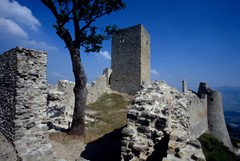Carpineti.
The Castle of the Carpinete Family
We now enter Carpineti, to visit the delightful historic centre which grew up around the striking Palazzo degli Amorotti. Just a few kilometres further on, we reach the peak of Mount Antoniano, on top of which perch arresting remains of the castle of the Carpinete family, one of the most important fortifications amongst Matilda of Canossa’s many properties. The castle’s origins are lost in the mists of time, and it cannot be excluded that the first foundations were laid by Atto Adalberto, Matilda’s enterprising ancestor, at the time of the Hungarian invasions in the X century.
Following expansion of the Canossa family’s possessions, the castle found itself at the heart of their lands and, together with other fortalices around Reggio, it formed part of a system protecting a huge, sprawling territory. As it happens, the castles of Matilda’s defensive checkerboard were arranged at three altitude levels and had different defensive functions.
At the first level are the fortifications in the area between Albinea and Casalgrande, the most important of which were the four Bianello castles that served as outposts.
At the second level, in the area between the towns of Baiso and Canossa, the castles of Canossa and Rossena were the most important and formed a potent central alignment.
The third level, and the most secure, was the Castle of the Carpinete, strongly constructed at a height of 805m above sea level, far from easy to storm, and flanked by numerous neighbouring strongholds which it was in visual contact with.
The Castle lived through two fascinating periods: the first coinciding with Pope Gregory VII’s stay in 1077, the second in 1092 when the famous meeting was held by Matilda to decide whether to continue the war with Emperor Henry IV, or desist, despite positive expectations of victory after long years of war.
From an architectonic point of view, the castle is surrounded by a first ring of walls that run outside the steep perimeter surrounding the peak of Mount Antoniano, adapting itself to the lie of the land and renouncing regularity in lieu of defence. The west side of the castle walls shows traces of the ancient gunports as well as projecting devices for machicolation, a system that made it possible to drop stones, pitch or other incandescent liquids on any enemies that attempted to climb the protective walls.
The entrance is situated on the south side, exactly where it was in the Middle Ages, and the inner courtyard is reached through a covered walkway. The fortified enclosure embraced storerooms, kitchen gardens, houses and stables, as well as various haphazardly arranged buildings, resulting from modifications which the successive lords who owned the castle carried out at different times. These buildings included accommodation for the artisans and peasants, a chapel, the owner’s residence and storerooms. The noblemen’s palace was built on two floors; the one at ground level for services, and the upper floor as the residence. Today traces of the stairs to reach the upper floor are still visible. During archaeological excavations carried out in the ’90s the remains of underground rooms were found that had remained hidden for centuries. Sandstone walls indicate the presence of basement rooms entered via a stairway that still remains.
Near the noblemen’s palace a small church from Matilda’s times dedicated to Holy Mary has recently come to light. The walls are made of large blocks of rectangular stone, while the apse features two loopholes. Also dating to Matilda’s times, the centre of the building has a floor paved in irregular sandstone slabs, bound together with lime mortar. In this area excavations have also brought to light a curious circular mass 140cm in diameter, incorporated into the floor. Next to the small church of the Holy Mary is an ancient sacristy.
A second line of walls served as internal protection for the water tanks and the keep, the last line of defence against enemy aggression. The keep is very well preserved even if the four internal floors no longer exist, and may only be recognized thanks to traces on the walls. From the top of the keep, accessible by climbing a system of internal stairs, visitors can enjoy a breathtaking panorama that takes in the Tresinaro valley to the north and that of the Secchia to the south, while on clear days the profile of the Apennines appears from which rise the Cimone, Cusna and Prampa peaks. Of remarkable interest is the village church dedicated to Saint Andrew, lying outside the fortified perimeter, which was consecrated in 1077, and remained intimately linked to the castle for centuries by various historical vicissitudes. The oldest parts, datable to the XI to XIV centuries, are the west-facing façade and certain stretches of the south side.
After Matilda, Carpineti saw peaceful times until the 1500s, when a slightly shady but at the same time affable figure shook up the tranquillity of the Apennines near Reggio. This was one Domenico Amorotti, known as Amorotto, a man of culture and chivalrous ways, but at the same time a rebel inclined to violence. It was no accident that he clashed with the allies of the Duke and the soldiers of the Bishop of Reggio Emilia, a city he ended up attacking in 1519. This revolt brought him an accusation of rebellion and a large reward was offered for his capture. Fleeing to the mountains, Amorotto became, along with his bloodthirsty brother and other companions, a real scourge for the populations of the valleys who became victims of constant thefts, robberies and murders.
After becoming a faithful ally of the new Pope Adrian VI, he was handed the castle of the Carpinete, which became his residence and a base for his continued vendettas and mayhem, which only ended with the violent death of himself and his brother in 1523. Even today numerous legends persist about Amorotto and his brother that tell of the bandit who terrorized the mountain populations for decades.
